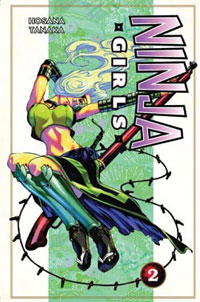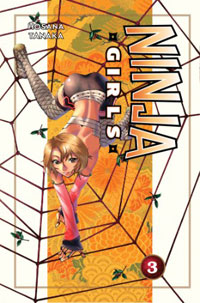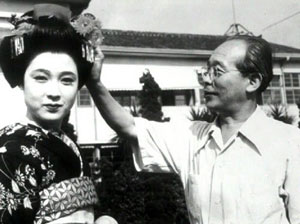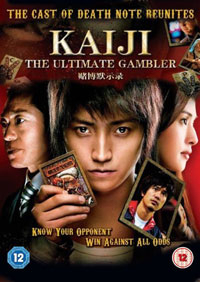 Logo handmade by Bannister
Column by Scott Green
Logo handmade by Bannister
Column by Scott Green
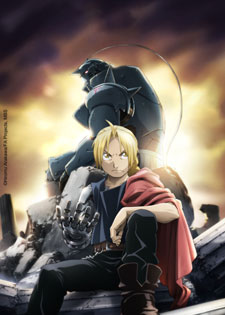
Anime Spotlight: Fullmetal Alchemist: Brotherhood Set 1 - Episodes 1-13 Released by FUNimation
The original Fullmetal Alchemist stands out in my mind as one of the few long series that really drew me in since becoming a regular anime writer and beginning this column in 2000. It never makes it to my lists of top anime or favorite anime, but whereas 50 episodes series like the various Gundams, Blood+, or Eureka Seven were projects to work through, I couldn't wait to see how Fullmetal Alchemist developed from episode to episode, volume to volume. Given my media consumption, usually I'll get around to something when I need to or find it in front of me. Curiosity concerning something new is one thing, but I rarely can't wait to see the next installment. With a combination of stakes, convincing characters, well animated action, and an appropriately convoluted plot, Fullmetal Alchemist was exceptional. The series was popular in Japan. The series was popular in North America. When an anime series adapts an ongoing manga, it often runs out of material to convert. At that point, it can generate its own stories with muted consequences so as to continue without impacting or contradicting the main narrative. Fans generally, dismissively refer to this as "filler." (See Naruto or One Piece) Or, it can diverge from the original course of the manga. (See Trigun or Ruruoni Kenshin, though in the latter case, it might have been a situation of never having the opportunity to return from the filler to the manga). Fullmetal Alchemist was well served by the momentum it had established before exhausting the manga. So, it made sense for it to go the divergent route. Fans of the original manga weren't entirely enamored with the new material, but, Bones' projection for the latter part of FMA generally got positive marks. This offered a justification for capitalizing on the lingering popularity of and good will towards Fullmetal Alchemist with a rare turn around. The 2003-2004 anime has been remade as Fullmetal Alchemist: Brotherhood, running, April, 2009-July 2010. Bones remained the production studio. Director Seiji Mizushima (Shaman King, Mobile Suit Gundam 00) was swapped out for Yasuhiro Irie (Alien 9, Kurau Phantom Memory). Writer Sho Aikawa (Gad Guard, 12 Kingdoms, Urotsukidoji) was replaced by for Hiroshi Onogi (Macross, Arjuna, Aquarion RIN ~Daughters of Mnemosyne~ - see the review of that for some Onogi impressions). In practice, if you have preconceptions about these folks, forget them. Hiroshi Onogi doesn't get to drop in his divisive spiritualism (beyond the manga's more metered variety). Bones doesn't get to work their formula of varying episodes by building, resting and delivering. Voice actresses Romi Park and Rie Kugimiya return as protagonists Ed and Al Elric, while the rest of the cast mixes familiar voices (Winry , Hughes, Armstrong ) with newcomers (Riza Hawkeye, Roy Mustang). Beyond the staff changes, there was a critical shift in operating principles. Raher than launch an anime series based on the foundation of the manga, Brotherhood would aim to adhere to Hiromu Arakawa's original work. To describe it uncharitably, fannish obedience replaced faith in the studio and the medium. Maybe in the long run, Brotherhood will be well served by the approach. This first set of 13 episodes have an unenviable task. The creators know that the audience who saw the original want to get through this quickly, but that new viewers need most of what was depicted. That translates to the viewing experience. The series takes off, and immediately has to cover early material in which the original had already mirrored the structure of the manga. Fullmetal Alchemist is set in a world physically and metaphysically governed by the Law of Equivalent Exchange, which an alchemist may utilize to turn one form of matter into another. Set on a landscape not unlike the early 20th century, states employ the users of this sort of almost magic to bolster their military and research capabilities. Breaking the fundamental taboo of alchemy, to resurrect their mother Alphonse Elric lost his body and his older brother Edward lost a leg. Quickly reacting to the disaster, Ed sacrificed an additional arm binding Al's soul to suit of armor. Then, to again press the limits of the matter transmuting power, this time to restore their bodies, Ed outfits himself with auto-mail prosthetic limbs and trades freedom for knowledge by enlisting as a "dog of the military," joining his nation's State Alchemists. It's an effecting story. Incrementally, Ed trades his moral standards in pursuit of the obligation he put on himself to restore his brother's body. The whole matter is built around a principle of consequence. Nations, families, cadres and individuals transcribe a loop in which pursuit of their goals blow back on them, causing them to pursue new ends to correct the results of the last iteration. In general, the appeal of anime is that it offers characters that draw the viewer's empathy and presents them in a manner that offers a new experience. The original Fullmetal Alchemist scores in these regards. It was easy to comprehend the Elric's dedication, even if they occasionally damned themselves by association or action. It had the military uniform aesthetic that anime fans have liked over the decades (see Gundam's fascist Zeon faction), and, it was set in a distinctive early modern age-ish era against the backdrop of a relevant seeming war against a religious people from an arid location. As such, it commanded and maintained attention. I imagine that a newcomer to Fullmetal Alchemist can follow Brotherhood. All the systems of the setting and motivations are certainly explained. Without being able to unsee the original, it seems like If I were seeing this for the first time, I'd wish it'd slow down and develop rather than track a staccato beat of events. Gundam Wing is what comes to mind. That anime started with five space colony teens, coordinated, but working individually to launch a war against Earth. The status quo would get shaken up, then again. Its pilots would find themselves working with one faction, or forced to trade their godly powerful robots for the enemy’s cannon fodder model, or they'd pull in a new group of allies, and always I'd wish the anime had stopped a while to explored what that situation entailed. At most, this first stretch of Brotherhood allocates an episode to a situation. Characters are introduced, and shuffled off just as quickly. It's moving on before you can mentally engage a situation. The actual depicted events only serve to accentuate this. It's as if half the time Ed and Al are recuperating from their last catastrophic encounter, on a train to travel to the next spot to grasp at straws in the chase for the philosopher’s stone, or both. The way that Gundam Wing kept on flipping the script, Fullmetal Alchemist keeps on testing Ed and Al. How much more innocence will they sacrifice to advance their aims? That sort of erosion doesn't register in this blitz. If there's an alternative theme in the Brotherhood version, that hasn't registered either. The constant assault might come off as a gauntlet for Ed and Al, but the problem there is that there's little coordinated opposition. It's explicitly made evident that the various people Ed and Al fight would be just as liable to fight each other. There's either scenes of them doing just that or statements to the effect. It's a battle royale. It's chaos. I don't think that it's accidental that the only character I found effecting in this set of episodes was Ed and Al's master in alchemy, martial arts, and much else, Izumi. She's supposed to have an immediate impact, and her experience and tragedy are etched on her. It's her that's interesting, not her active evolution. As such, she isn't diluted in the transition to a hurried form of Fullmetal Alchemist. "The same, but different" is supposed to the ideal for revisiting well liked material, but it doesn't serve Fullmetal Alchemist well. I found myself spending the time I was watching the anime nit picking and being drawn to what I didn't like. Ed's long hair bothered me. Here's a guy (teen, really) who practices martial arts, who joined a military organization, who has bangs the length of his face and hair past his shoulders. While I've never disliked the character, I kept wishing one of his adversaries would grab that hair and pop him in the face. Incidents of young girls tied to tragic events happen twice in rapid succession, casting it as unrestrained manipulation. In what little I read of the Fullmetal Alchemist manga, I liked the quirky cartooning style used when interjecting humor. I had patience for the jokes in the previous anime. As it exactingly reproduced the manga, I felt that it was not to this anime's benefit to use these obtrusively stylized deviations popped into otherwise serious conversations. I wouldn't be surprised if Fullmetal Alchemist: Brotherhood improved significantly after it branched from the original anime. And, I am not surprised that this remake of a popular anime, adapting a popular manga rushed through the ground work material, towards what the fans of the franchise want to see. That doesn't make this early going any more solid. It's an unusual situation for anime: material that is wanting that still makes future installments an intriguing prospect.
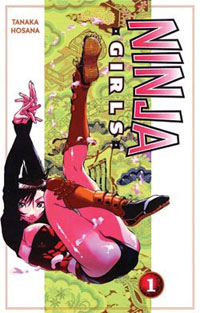
Manga Spotlight: Ninja Girls Volumes 1-3 by Hosana Tanaka Released by Del Rey Manga
It has to be said, Ninja Girls does what it says on the tin. You certainly can't complain of false advertising here. Wanna see buxom young women in exotic, skintight outfits smash baddies with super ninja powers? You're in luck. If you want to see risqué women in peril, bondagey stuff, you're good to go. If you want, skin and sex, you might be disappointed. The manga stops just short. Ninja Girls, aka Rappi Rangai, ran in Shonen Sirius, an anthology dominated by moe or bishojo manga, with cute girls integrated into various genres from sci-fi/fantasy to horror like Princess Resurrection. Here, the girls are the chief attraction. It's a bit naughty... a key scene involves the characters stripped to their undergarment, tied up and imprisoned while one of the ninja girls bleeds from a leg wound... until an orgasmic burst of excitement allows her to break her bounds. And, the manga is a bit kinetic... Tanaka doesn't pay much attention to panel to panel transitions or composition in the fights and as such the choreography is basic, but zip tones and inks are used well with the fleshy characters to give scenes of things hitting each other some pop.Ninja Girls opens with the manga identifying itself as being set in the Sengoku, also known as the Era of Warring States, the chaotic period prior to Japan being unified under the Tokugawa Shogunate. One of the clans wiped out in the contests of power was the noble Katana. The lord committed suicide. His household was exterminated. In the wake of this tragedy, the Katana's vassals went out searching for remnants. Raizo lived as a poor orphan, ostracized from his village due to the horn growing out of his head, seen by many to mark him as a demon. Guided by his mother's spirit inhabited memorial tablet, which reacts by tipping over or occasionally correctively striking him, Raizo barely contains his rage and disappear. On day, he finds a woman in shapely armor washed up on the river bank. He's aroused, but he manages to carry her home, pump the water out of her chest, give her mouth to mouth, take off her wet clothes and pour some sake into her mouth to warm her up. Yeah, that's the sense of humor at work here. As Raizo begins to notice how many bladed weapons she had secreted in her clothes, the woman wakes up, and isn't too please to discover her unclothed, boozed situation. Fortunately for Raizo, her maidenly rage is calmed when the misunderstanding is cleared up. Turns out, Kagari almost drowned herself in a reed snorkel, ninja hiding related miscalculation. Her view of Raizo further shifts when she discovers the horn on his head. Rather than the mark of demonic heritage, the horn is proof Raizo is a remnant of the Katana bloodline. Fired up by his proximity, Kagari can shift into Shintaigo god body mode and waste some newly arrived adversaries. So, Kagari swears allegence to Raizo, as does relatively elder, busty, one eyed sharp shooter Kisarabi and androgynous, s&m-y trapster Himemaru. Together, they plot to restore the Katana as a substantial household under Raizo... marriage alliance seeming to be a solid option for achieving the aim. If you don't think you'll like a manga that exists to showcase heavy chested ninja girls getting tied up by or smacking around other ninjas, there's no reason why you'll like this one. The faults of a manga like this can't be anything but apparent. Narrative, well constructed characters or concepts, anything thoughtful for that matter... they're not in the offering. And yet, if you are inclined towards the material, you can appreciate how Ninja Girls is careful not to stagnate or irritate. Raizo is a bit spine-possessing as anime/manga characters in his circumstances go. Despite being all surface, there's plenty of energy radiating from the rest of the cast as well. The story quickly scootches in and out of situations. It set on tapping substories for less than a volume's length, with troubles related to a given potential bride set up and resolved in less than a hundred fifty pages. Volume three for example, introduces a mess of Yagyu, the famed family of sword masters that yielded the adversaries of Lone Wolf and Cub and the semi-historical legend Jubei Yagyu, inspiration for a host of anime, manga, novels and video games. A succession fight tournament and a preamble encounter with the ninja girl's master are worked through by the volume's conclusion. Without being perfunctory, the manga gets through a set of excuses for extravagantly revealing new costumes and dismembering fights with freakish foes, wraps it up and is ready to present something new before too much thought distracting can be applied. Ninja Girls is spectacularly unapologetic. In no way does it veil its low minded intensions. It's gladly trashy. I could name plenty of junk manga I'd rather see released in North America, but I'm still glad this one has made it over. I'm glad the avenue to this low field in the diversity of manga hasn't been closed off.
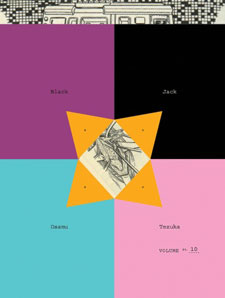
Manga Spotlight: Black Jack by Osamu Tezuka Volume 10 Released by Vertical Inc
The format of Black Jack wasn't one of legendary manga creator Osamu Tezuka's manga innovations, but the structure did allow him to explore and test a wide range of ideas. Each twenty something page chapter, originally published weekly in Shonen Champion, would encapsulate its own story. They wouldn't contradict each other, and a handful of characters were developed across multiples, but few stories even referenced another. Stories that spell out what resonates through its reoccurring characters' lives feel exceptional. The tenth volume of Black Jack closes the circle on the titular maverick doctor's mysterious past, as it captures the anti-heroes dealing with his father (for good measure, it also explains why he lives in a small, almost excessively unassuming seaside cottage). Having previously been granted access to the truth behind Black Jack's scarred visage, and the purpose towards which he applies the exorbitant fees he commands for his mercenary medical practice, this feels like an ultimate bit of unfinished business. Tezuka had already been tipping the scales towards nurture and against nature over the course of this dialectic, but this particular confrontation seals the point of view in a surprising way. Stories and volumes of the collected Black Jack are organized editorially rather than in publication order. It's possible to read a theme into a given volume. Compare a recently released to early ones in which Tezuka was actively testing his ideas concerning medical ethics against his manga avatar and the contrast between groupings of stories is stark. I'd call this the volume of screw ups. Often due to misplaced priorities, thoughtlessness, miscalculations and mistakes, yield unintended consequences. Maybe not as a rule, but there's a plenty of manga that will evoke a serious subject out of some narrative obligation. A story needs to be about something, so something semi-relevant is grafted on. In contrast, Tezuka's manga is discernably interested in making a point. The implications aren't just noise or justification, they're what excited the creative process. What’s particularly great about this volume is how ambiguous a lot of it is. While adults are screwing up, Tezuka isn't raising up children or the qualities of childhood. Tezuka's manga expresses a great compassion for humanity, but he is also darkly mournful of its failings. Black Jack's confrontation with his father is the crucial chapter of the manga. In X-Files parlance, it's a mythology episode, and those are rare in this case. I don't want to downplay it, but what really piqued my curiosity was "Pinoko Returns." The title refers to Black Jack's assistant/adopted daughter/"wife," who is aged is zero, about five, or eighteen depending on your reckoning. She was a "teratogenous cystoma" parasitic twin that Black Jack removed and gave an independent, childish body. The story sortof relates to the larger framework of the manga series in that it touches on Black Jack's recognition by the medical establishment. It's simple. A sad sack mole-man-ish fellow tries to burglarize Black Jack's cottage. Pinoko decides to help him and the lovably inept pair wind up on the town for a day that ends up costing Black Jack in several respects. It's a lovely sad clown affair, both humorous and pitiable. It doesn't provoke as simple response. It didn't speak down to its audience. I've love to know what Shonen Champion readers made of it. As much as I revere Tezuka, I have to admit that I'm a bit surprised that I can still come up with intelligent, at least somewhat fresh reaction to the manga after 10 volumes. That's something special. There are plenty of manga series that I love that I can't say that for. "Dynamic" is probably the wrong adjective for Black Jack since each story is different. "Flexible" is probably better. And with that flexibility, Tezuka produces some amazingly provocative and thoughtful stories.
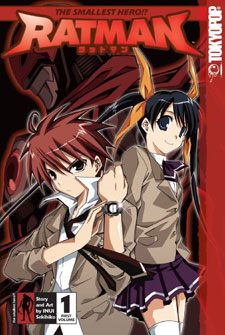
Manga Spotlight: Ratman: The Smallest Hero?! By Inui Sekihiko Released by Tokyopop
In Watchmen and Top 10, Alan Moore posited that if costumed crime fighters existed, young people wouldn't be fascinated by them. Media like comics would instead be dedicated to pirates, lawyers... something other than costumed violence. Ratman isn't exactly an Alan Moore comic. Shuto Katsuragi lives in a world in which individuals in flashy costumes, often backed or promoting some business, do battle with villains, and yet he's a wide eyed enthusiast. To the chagrin of his younger sisters and classmates, he mimics the postures of heroes, reads up on them, and otherwise declares his adoration. Though is short stature is supposed to underscore how unprepared Shuto is to actually be a hero, his mock hero theatrics rises to the level of accidentally provoking local toughs. One day, a female classmate who had humored his eccentricities is kidnapped, propelling Shuto into a situation that allowed him to realize his fanboy dreams. Meeting up with a waylaid hero, Shuto is given a transformation watch, allowing him to become costumed, super powered Ratman and rescue the classmate. Thing is... it was all the ploy. Shuto was set up by his classmate’s elder sister and her cadre of mad scientists and skull faced Jackie minions to become a henchman of the secret, evil organization JACKAL. Though, even if it doesn't mesh with Shuto's expectations, maybe it's not a bad thing to be bad in the world of Ratman. While the ostensible heroes are compromised or outright greed-heads, JACKAL folks have a quirky self-defining appeal to them. The frequent comment is that Ratman is a manga take on American style super-heroes. Really, the formula is closer to tokusatsu live action special effects driven series of the TV variety. Power Rangers is still the most readily available point of reference. Think of the scheming master villain. They stay off the battlefield and ready monsters to attack. That's the classmate’s sister. Then, there's the army of masked, non-individualized, easily defeated foes. That's the Jackies. The episode based foes haven't showed up, unless you count some of the heroes. Then, there's the reoccurring henchmen, and that's Ratman. It's not not a superhero parody. There's shared history in genres. But, the joke is more specifically based on the tropes of those tokusatsu shows than Spider-Man, Superman and the like. Tell an anime/manga enthusiast that a tokusatsu parody is getting released in North America, and they'll probably ask "why not Astro Fighter Sunred?" Though neither the anime nor the manga have been licensed, it has an excellent reputation. The joke there is that its title character guards a river side suburb while exercising the minimum effort required. He ignores his girlfriend. He half asses his work. He shows up in a t-shirt over his red Power Rangers-like masked outfit, cigarette and hand, and gets by with his ability to thump foes without breaking a sweat. In contrast, his evil looking adversaries, General Vamp and Florsheim's Kawasaki Branch are generally considerate and fine citizens. Astro Fighter Sunred runs in Square Enix's Young GanGan (thus, if it were to be released in North America, it would probably be from Yen Press). It's for a kindof older audience. And that's why I'd be mildly surprised it were licensed. While seinen has dominated the Eisner nominations for manga, commercially, a manga about a masked twenty something listlessly stamping out cigarettes and having a contentious relationship with the coinhabitating girlfriend is a bit of an iffy prospect commercially. Ratman runs in Shonen Ace, home of also Tokyopop recently release Deadman Wonderland. This anthology is known for its many anime tie-ins, mostly of the mecha variety such as Neon Genesis Evangelion, various Gundam and various Macross. As the name implies, it's for a shonen, teen boys, audience, but it skews older than periodicals like Shonen Jump or Shonen Sunday, as it features darkly disturbing, and/or violent works, often populated by older characters such as Goth (teens investigating murders due to their pathological fascination with violent crime), Anne Freaks (a teen on the run after killing his mother combats a terrorist cult), MPD Psycho (a police detective/criminal profilers/serial killer with multiple personality disorder, adapted for TV by the infamous Takashi Miike), and Kurosagai Corpse Delivery Service (underemployed Buddhist college grads find work transporting corpses to where the dead need to be). Sunred's a bum, and probably will continue to be one through the course of his non-narrative comedy serial. As much praise as Astro Fighter Sunred gets, selling that sort of work is tricky. In contrast, Ratman is driven by Shuto's perspective. For a Shonen Ace action comedy, written with the expectation of hitting a geek audience, the manga mixes an appropriate cocktail of aspirational idealism, hormones and cynical distrust. Without entirely dismissing Shuto's hero enthusiasm, it sets him up via his fumbling with female peers such that he crashes into the feet of clay beneath his idols. The consequences are light comedy with a bit of rebelliousness. He gets the chance to distinguish himself , even if the delineations of the world weren't were he thought they were. Inui Sekihiko is a concept guy, especially remixing the familiar. Before Ratman, his big work was Murder Princess, a fantasy in which a princess and mercenary woman swap bodies, leaving the sword wielding foe-smasher in a gown and crown and with the former princess serving as the warrior's maid for the good of her kingdom. In the execution of these concepts, he works through visual, mostly physical humor. The gangly, puppy dogs in skull masks Jackies are good for a smirk. The martial artsy-bits of Ratman are generally a solid it. The daughter of a trainer to the heroes springing onto the shoulders of a bully then leg tossing him onto the pavement was better looking action than might be expected from a parody focused series. The appearance of a Billy Banks doppelganger combines this with a nice sight gag. You've probably seen funnier manga and more exciting manga. The teen geek perspective, the action and the humor complement each other well enough that Ratman succeeds in being entertaining. No element is transcendent enough to be memorable, but as read it, and don't think too much more about it manga, Ratman does the trick.
Event News
More here Twitch talks to programmer Grady Hendrix* The NYICFF will be bringing back Sita Sings the Blues June 12, 13, 19, 20 - 11:00am - IFC Center, 323 Sixth Avenue (at West Third) Tragedy, comedy and musical collide in this gloriously animated film from Nina Paley, New York's own "One Woman Pixar" (Wired Magazine). Sita is a goddess separated from her beloved Lord and husband Rama. Nina is an animator whose husband moves to India, then dumps her by email. Three bickering shadow puppets with Indian accents act as comic narrators as these old and new stories are interwoven in a post-modern retelling of the ancient Indian epic, Ramayana, animated in a dazzling mix of traditional and collage animation styles.* Bandai Entertainment announced that a subtitled print of The Disappearance Of Haruhi Suzumiya will screen for one night at the Laemmle’s Sunset 5 theater in Hollywood on June 24th, English Voice actress Stephanie Sheh (Mikuru) will appear with more cast to be announced as they confirm availability. Cristina Vee of Bandai’s ASOS Brigade.com will be performing several of the series songs in English and Japanese prior to the film The English subtitled print of the film will be shown in Hawaii in the near future by Consolidated Theaters ( and Artisan Gateway as part of their SPOTLIGHT ASIA FILMS Program. Hawaii dates and venues will be announced* AniPlex presents a message from Gurren Lagann voice actor Katsuyuki Konishi concerning his appearence at Anime Expo For more, see the Gurren Lagann movie site Danny Choo will be presenting a 10 minute preview of Black Rock Shooter at Anime Expo Digital Manga Publishing announced their Anime Expo presense Digital Manga will be in booth #500-between Bandai Entertainment and Funimation at hall front. Panel descriptions: Digital Manga Publishing Industry Panel: Day 1 (July 1st) at 5:00 PM in LP2. What we'll be covering: A brand new exclusive venture Digital Manga Publishing is doing in tandem with another major manga publisher. eManga and some interesting and exciting additions to come for the site. Some new licenses we'll be announcing, including some Japanese publishers we'll be working with for the first time! We're trying to reschedule Pop Japan Travel's panel, so if we are unable to do so-they'll be joining the DMP panel on this day. Gungrave Industry Panel: Day 2 (July 2nd) at 11:00 AM in LP4. What we'll be covering: Some exciting news for GUNGRAVE fans! Come and hear about a couple of very exciting new projects brought to you by DMP, Convergence Entertainment and RED Entertainment. Something new is brewing in the air around the very popular Gungrave property courtesy of Yasuhiro Nightow. Joining DMP will be representatives from Convergence Entertainment and RED Entertainment. Pop Japan Travel: Day 4 (July 4th) at 2 pm in LP4 Pop Japan Travel is the premiere pop culture tour organizer for Japan! Pop Japan Travel has taken their tour guests all over Japan in search of the best in Japanese pop culture. They've visited maid cafe's, seen giant Gundam statues, met mangakas, visited top anime studios, been to the biggest comic and video game conventions...what do they have in store coming up?! Meet Gigi and Evan-Pop Japan Travel's tour organizers to hear what they have planned for the coming year...and check out some exclusive tour footage! Go to Japan and see what YOU want to see! (This panel is subject to schedule change-check back with us for any changes!)* A look at Junko Mizuno's San Diego Comic Con sketch, where she and Last Gasp will be promoting Little Fluffy Gigolo Pelu* Yoskay Yamamoto "Intimate Strangers" from Jeremy Asher Lynch on Vimeo.
* Baltimore's Otakon has added writer and "pop culture diplomat" Takamasa Sakurai and adaptation director Christopher Bevins to its list of guests* Anime Weekend Atlanta has announced Shinji Aramaki (director and Production Designer for Halo Legends - Director of Appleseed: Ex Machina and Appleseed), Laura Bailey ( Maka in Soul Eater, Shin in Shin Chan, Tohru Honda in Fruits Basket, Lust in Fullmetal Alchemist) and Travis Willingham ( Colonel Roy Mustang in Fullmetal Alchemist) have been added to the events list of guests* San Francisco's VIZ Cinema and NEW PEOPLE s will spotlight Kenji Mizoguchi as part of the theatre’s Untold Legends series with runs throughout June. Director Kenji Mizoguchi’s signature is the expression of strength, sorrow, and fragility of women, and his mastery of the long take and mise-en-scène are legendary. His 1953 film, Ugetsu, won the Silver Lion at the Venice Film Festival and his films went on to have a tremendous impact on Western directors including Jean-Luc Godard, Andrei Tarkovsky, Jacques Rivette, Rainer Werner Fassbinder, and Theo Angelopoulos. VIZ Cinema proudly presents four of Mizoguchi’s greatest works – Sisters of the Gion, Ugetsu, Street of Shame, and Utamaro and His Five Women – in crisp 35mm with English subtitles.Sisters of the Gion, June 19th – June 21st and also June 24th (1936, 69min, 35mm, with English Subtitles) Sisters of the Gion follows the parallel paths of the independent, unsentimental Omocha and her sister, the more tradition-minded Umekichi, who are both geishas in the working-class district of Gion. Mizoguchi’s film is a brilliantly shot and provides an uncompromising look at the forces that kept many women at the bottom rung of the social ladder. Ugetsu, June 19th – June 22nd (1953, 94min, 35mm, with English Subtitles) Ugetsu is a ghost story like no other and the Japanese director’s supreme achievement. Derived from stories by Akinari Ueda and Guy de Maupassant, this haunting tale of love and loss – with its exquisite blending of the otherworldly and the real – is one of the most beautiful films ever made. Street of Shame, June 19th – June 20th and June 22nd – 23rd (1956, 87min, 35mm, with English Subtitles) For his final film, Mizoguchi brought a lifetime of experience to bear on the heartbreaking tale of a brothel in Tokyo’s red light district, full of women whose dreams are constantly being shattered by the socioeconomic realities that surround them in post-war Japan. Utamaro and His Five Women, June 19th – June 20th and June 23rd – June 24th (1946, 106min, 35mm, with English Subtitles) Inspired by the life and work of the wood block print artist, Utamaro Kitagawa (1753-1806), who revolutionized the medium by capturing human emotion into his artwork, Utamaro and His Five Women is a fascinating study of a man’s dedication to his art and adherence to self-expression in a time of rigid conformity. VIZ Cinema and NEW PEOPLE Untold Legends will also feature four films by director Yasujiro Ozu Yasujiro Ozu is one of the most influential film directors of the 20th Century and his Tokyo Story is consistently is ranked among the Top 10 films of all time. From Jean-Luc Godard to Wim Wenders to Aki Kaurismäki, many of cinema’s most acclaimed filmmakers have been deeply influenced by Ozu. VIZ Cinema proudly presents his four masterpieces – Tokyo Story, The Only Son, Record of a Tenement Gentleman, and Early Spring – in precious 35mm with English subtitles. Tokyo Story, June 12th – 14th and also June 17th (1953, 136min, 35mm, with English Subtitles) Tokyo Story follows an aging couple, Tomi and Sukichi, on their journey from their rural village to visit their two married children in bustling, postwar Tokyo. Their reception is disappointing. Too busy to entertain them, their children send them off to a health spa. After Tomi falls ill she and Sukichi return home, while the children, grief-stricken, hasten to be with her. From a simple tale unfolds one of the greatest of all Japanese films it depicts generational conflict in a way that is quintessentially Japanese and yet so universal that it continues to resonate as one of cinema’s greatest masterpieces. The Only Son, June 13th – 14th and also June 16th (1936, 82min, 35mm, with English Subtitles) Yasujiro Ozu’s first talkie, the uncommonly poignant The Only Son is among the Japanese director’s greatest works. In its simple story about a good-natured mother who gives up everything to ensure her son’s education and future, Ozu touches on universal themes of sacrifice, family, love, and disappointment. Spanning many years, The Only Son is a family portrait in miniature, shot and edited with its Ozu’s customary exquisite control. Record of A Tenement Gentleman, June 13th, June 15th and also June 17th (1947, 72min, 35mm, with English Subtitles) A man finds a lost boy in a war-torn village and brings him to his tenement. He tries to find someone to take care for him but no-one accepts the responsibility. The child eventually ends up with a sour widow Tané despite her refusal. Early Spring, June 12th – 13th and June 15th – 16th (1956, 144min, 35mm, with English Subtitles) In his first film after the commercial and critical success of Tokyo Story, Ozu examines life in postwar Japan through the eyes of a young salaryman who, dissatisfied with career and marriage, begins an affair with a flirtatious co-worker. * Members of the Mighty Morphin'/Zeo/Turbo Team will be in Los Angeles, CA at Club Nokia-MAXimize the Experience on July 1, 2010* For those who like risque movies, upcoming Pink Eiga screenings include June 25th – 7pm ~ 10:30pm A Pinksummer Night’s Dream: Exploring the World of Pink Eiga A LONELY COW WEEPS AT DAWN & DEEP CONTACT 7:00pm – 10:30pm Gallery Nucleus 210 East Main Street Alhambra, CA July 2nd – Midnight New York Asian Film Festival Pink Power Strikes Back! THE JAPANESE WIFE NEXT DOOR: PART 2 & GROPER TRAIN: SCHOOL UNIFORM HUNTER! Midnight at the IFC Center - 323 Avenue of the Americas, New York, NY Special Guest - Reiko Yamaguchi!!!!!! July 12th @ 5pm and July 17th @ 11pm Another Hole in the Head Film Festival Yojiro Takita’s – SEXY TIMETRIP NINJAS The Roxie Theater 3117 16th Street San Francisco, CA 94103* Japan's National Museum of Emerging Science and Innovation will run an exhibit of gadget inspired by classic manga Doraemon June 12 - September 27, 2010* Patrick Macias on the Vocaloid idol concert* The Dallas Observer chronicled the A-Kon anime convention here and here* An Otaku USA(/Colony Drop) report on the Fanime convention One wonders why FanimeCon doesn't change its focus and become a general purpose nerd and Japanese culture convention, as it's obvious that anime is no longer the main draw for many attendees. It seems clear that as the Western anime industry continues to shrink and more companies go under, anime conventions will be forced to fill their programming schedules and guest rosters with activities and people who have no relation to Japanese animation. At what point does the name FanimeCon become silly, considering how little of the con actually concerns anime? Authority Dave Merill gives his take Gilles Poitras has report from Fanime panels Older Titles for Newer Fans Manga for Grownups The Japanese Sex Trade in Anime and Manga
Digital Distribution News
A coalition of Japanese and U.S. publishers announced a coordinated effort to combat a rampant and growing problem of internet piracy plaguing the manga industry. “Scanlation,” as this form of piracy has come to be known, refers to the unauthorized digital scanning and translation of manga material that is subsequently posted to the internet without the consent of copyright holders or their licensees. According to the coalition, the problem has reached a point where “scanlation aggregator” sites now host thousands of pirated titles, earning ad revenue and/or membership dues at creators’ expense while simultaneously undermining foreign licensing opportunities and unlawfully cannibalizing legitimate sales. Worse still, this pirated material is already making its way to smartphones and other wireless devices, like the iPhone and iPad, through apps that exist solely to link to and republish the content of scanlation sites. Participants in the coalition include the 36 members of Japan’s Digital Comic Association, Square Enix, VIZ Media, TOKYOPOP, Vertical, Inc., the Tuttle-Mori Agency and Yen Press. Working together, the membership of the coalition will actively seek legal remedies to this intellectual property theft against those sites that fail to voluntarily cease their illegal appropriation of this material. “It is unfortunate that this action has become necessary,” said a spokesperson for the group. “However, to protect the intellectual property rights of our creators and the overall health of our industry, we are left with no other alternative but to take aggressive action. It is our sincere hope that offending sites will take it upon themselves to immediately cease their activities. Where this is not the case, however, we will seek injunctive relief and statutory damages. We will also report offending sites to federal authorities, including the anti-piracy units of the Justice Department, local law enforcement agencies and FBI.” The coalition stated that it has currently identified thirty sites targeted for action. Participant members of the Digital Comic Association include: Akane Shinsha, Akita Shoten, ASCII Media Works, East Press, Ichijinsha, Enterbrain, Okura Shuppan, Ohzora Shuppan, Gakken, Kadokawa Shoten, Gentosha Comics, Kodansha, Jitsugyo No Nihonsha, Shueisha, Junet, Shogakukan, Shogakukan Shueisha Production, Shodensha, Shonen Gahosha, Shinshokan, Shinchosa, Take Shobo, Tatsumi Shuppan, Tokuma Shoten, Nihon Bungeisha, Hakusensha, Fujimi Shobo, Fusosha, Futabasha, France Shoin, Bunkasha, Houbunsha, Magazine House, Media Factory, Leed sha, Libre Shuppan Fan translation and raw Japanese manga aggregation site Manga Helper announced it will no longer host the media. Instead, it will launch Open Manga, an effort to get manga creators to sign on and make money via merchandise and donations. Publishers Weekly has a report here Deb Aoki gathers reaction The Eastern Edge talks to Moral Relativism and content piracy Erica Friedman on The Solution to the Scanlation Solution Helen Mccarthy on the effect of scanlation Alex Leavitt on The Problems with The Problem of Online Manga* Court papers on the HTML Comic piracy case* Five issues of Kodansha's Young Magazine are going online to celebrate its 30th anniversary Marvel Comics has begun offering some digital comics at the same time as release, but they'll cost more* FUNimation has begun streaming Negima! and manglobe (Samurai Champloo) fantasy Sacred Blacksmith on their site and YouYube. - the home video version will be unedited* Queens Blade will begin streaming on Crunchyroll* Anime News Network has announced the launch of its new custom video player with material including motorcycle sci-fi action series Blassreiter and Nobody's Boy - Remi. Nobody's Boy - Remi, will also launch on June 13, with five new episodes released every Sunday for 10 weeks. The 51-episode series, originally released on demand by ImaginAsian Entertainment in 2007, revolves around the sufferings of a young French boy who is sold to a street performer and forced to survive through harsh climates, near-starvation, and other cruelties. The 1977, Osamu Dezaki (Aim for the Ace, Golgo 13: the Profession) work adapting the Hector Malot novel was part of the revered World Masterpiece Theatre omnibus. Due to an existing license in Canada, the series will only be available in the United States. However, TMS has announced that the English DVD rights, merchandising, and rights for Latin American distribution are still available, and can be obtained directly from TMS Entertainment, USA, Inc. ANN will also host Toei animation including Galaxy Express 999 Captain Harlock Slam Dunk Pretty Cure Digimon Adventure 02 Air Master La Corda D'Oro Miracle Train ~Oedo-sen e Yokoso~* Shonen action title Bleach has begun simul-streaming on Crunchyroll BLEACH is now available on Crunchyroll in the United States, Canada, Mexico, the Caribbean, Central and South America, the United Kingdom, Ireland, the Netherlands, Sweden, Denmark, Norway, Finland, Iceland, Australia, New Zealand, and South Africa. The latest arc beginning with episodes 266 to 273, and the latest simulcast episode 274 was launched early this morning at 2:30am PDT, available to premium viewers. Tentatively on June 15th, episodes 266 to 274 will be free for all viewers, with the simulcast of episode 275 available to premium members. Thereafter, new episodes will be added at 2:30am PST every Tuesday, with simulcasts available for premium members and the previous week's episode being available to all viewers. Catch up of older episodes are planned and additional info will be provided at a later date.* To celebrate its Adult Swim airing, VIZ Media is offering a Download-to-Own (DTO) episode of Kekkaishi through VIZ Media partners iTunes, Xbox Live's Zune Marketplace, PlayStationNetwork and Amazon Video on Demand. KEKKAISHI Episode 1 will be available for free download through June 17th KEKKAISHI is based on the hit manga series by Yellow Tanabe (also published in North America by VIZ Media). A story of mystical forces powerful in the region known as Karasumori. For over 400 years, it has been the duty of a clan of “kekkaishi”—barrier masters—to guard this land and exterminate the supernatural creatures that are drawn to it night after night. Yoshimori Sumimura is a junior high school student at Karasumori Academy, which is built upon the Karasumori grounds. By night, Yoshimori follows the tradition passed down through generations and fulfills his destiny as the twenty-second “kekkaishi” of the Sumimura clan. But by day, Yoshimori's got other demons to contend with, like an obsession with cake making and a seriously crotchety grandfather! Yoshimori's pretty neighbor, childhood friend and rival, Tokine Yukimura, is also a “kekkaishi,” but their families are caught up in a feud over who is the true practitioner of the art. Protecting ordinary people from the ever-present danger of the Karasumori grounds, Yoshimori will continue to grow stronger as he battles the forces of evil again tonight!* Maid-Sama!, the latest series from director Hiroaki Sakurai (Cromartie High School, Revolutionary Girl Utena), will begin streaming this June on Anime Network Online. From J.C. Staff (Honey and Clover, Azumanga Daioh), comes the story of the most unlikely class president...ever! Ayusawa Misaki is the hard-boiled, hard-nosed, boy-hating class president of a former all male school, recently turned co-ed. A beacon of hope to the female students as well as teachers, she rules over the boys with an iron fist and a heart of ice. When a popular male student stumbles on to her secret double life, she's forced to make a deal: spend some time with him, or have her hard earned reputation destroyed by revealing her embarrassing secret: working part-time as an upbeat and cheery waitress at a maid cafe! Episode 1 will be available to Premium subscribers on June 15, and to Registered users on June 17. Episode 2 will be available on June 24, then one new episode per week every Thursday.* A bilingual version of Saori Oguri's autobiographical Darling wa Gaikokujin (My Darling is a Foreigner aka Is He Turning Japanese?) is now available for the iPad* Rumor is that streaming service Hulu is being added to Xbox 360 offering, possibly with "some sort of fee."
Upcoming in North America (and Other English Speaking Territories)
Following news of a Voltron anime TV series producers Richard Suckle and Ted Koplar told MTV Splashpage a live action movie is still in the works* * Johnny Sokko And His Flying Robot, the localized, live action Giant Robo is being offered by MGM DVD on Demand Marc Bernabé's (Japanese in Mangaland) Masters of Manga will feature interview with over 26 creators, including AKAMATSU Ken (Love Hina, Negima!) AOYAMA Gosho (Detective Conan (Case Closed), Yaiba) HAGIO Moto (The Heart of Thomas, The Poe Clan, They Were Eleven) KISHIRO Yukito (Gunnm -Battle Angel Alita-) MAKI Miyako (shojo and josei manga pioneer) MATSUMOTO Taiyo (Tekkonkinkreet, Number 5, Takemitsu Zamurai) OHWADA Hideki (Legend of Koizumi, Mobile Suit Gundam-san, UnP-sensei) SAITO Takao (Golgo 13, Survivor, Onihei Hankacho) TATSUMI Yoshihiro (A Drifting Life) UMEZU Kazuo (The Drifting Classroom, Orochi, Makoto-chan) URASAWA Naoki (Monster, 20th Century Boys, Yawara!, Pluto, Billy Bat) YOSHIZAKI Seimu (Kingyo Used Books)* Laeta Kalogridis (behind live action Ghost in the Shell) is an English-language adaptation of Serbian animated scif-i Technotise* Helen McCarthy (Manga: The Complete Guide, Art of Osamu Tezuka) is contributing to ImagineFX issue 58* Ryu Murakami's Audition, basis for the Takashi Miike book is now out on in North America* An animated Batman: Year One might be in the pipeline 4Digital Asia the UK's 4Digital Asia releasing the live action adaptation of Kaiji: The Ultimate Gambler on July 25, 2010Bandai Entertainment Bandai Entertainment has delayed some releases Moved from Jun 8 to Jul 6 Kurokami The Animation Part #2 DVD (Eps #7-12) Kurokami The Animation Part #2 DVD (BLURAY) (Eps #5-8) Moved from Jun 22 to Jul 6 Mobile Suit Gundam Zeta Movie #1: Heirs to the Stars DVD Mobile Suit Gundam Zeta Movie #2: Lovers DVD Mobile Suit Gundam Zeta Movie #3: Love is the Pulse of the Stars DVD Mobile Suit Gundam Zeta Movie Complete Collection DVD Boxed Set (Movie #1-3) Digital Manga Publishing ANN confirms upcoming DMP titles include Garden Sky (O-sora de Garden*) Yuko Kuwabara (Libre's Be-Boy Comics, one volume) Digital Manga Publishing Publisher's description: "A little god, 'Kami Sama,' who lives up in heaven has summoned two men to his place. 'Shiro' (white) cruised through life with wealth and happiness, relaxed and carefree. 'Kuro' (black) struggled and had hardships, suffering through his life. Now their comedic life as a dynamic trio is about to begin! What does mischievous Kami Sama have in mind?" Love Water (Giro no Koimizu) Venio Tachibana (Taiyoh Tosho's Shy Novels, one volume) Illustrated by Tooko Miyagi Digital Manga Publishing November 2, 2010 Publisher's description: "It's the beginning of the Meiji Era, and the world is turning upside-down. Misao doesn't think his life of tradition will ever change. Born into the pleasure quarters and raised as a courtesan, he knows that emotions are fickle things, changing with every hour. But when a rich man's son visits Misao's teahouse, Misao opens his heart for the first time. He pursues this reckless love on the cusp between two ages, yearning only for happiness and expecting nothing but pain. Can the world ever change for this prisoner of love?" Japan & Stuff Press Japan and Stuff has recently published The Manga Biography of Kenji Miyazawa by Ko Yano Kenji Miyazawa (1896–1933) is one of Japan's most beloved writers and poets. Some of you may know him from his fantasy novel “Night of the Milky Way Railway” (or the anime version, “Night on the Galactic Railroad”). Others may know him from his short stories, such as “The Restaurant of Many Orders.” Still others will know him from his poetry, such as “Someone who is unfazed by the rain.” Some have enjoyed the anime “Spring and Chaos,” which beautifully depicts the world of creativity and imagination in which he lived as a mature artist. Few in the English-speaking world, however, know the full story of his life in any detail. This is precisely the story told in “The Manga Biography of Kenji Miyazawa, Author of Night of the Milky Way Railway.” From being a somewhat odd child, to his early empathy for others, to his passion for rock collecting, mountain climbing, and the beauty of nature, to his study of soil sciences and fertilizers, his awakening to fantasy literature, poetry, and music, to the devastating loss of his sister, his religious conflicts with his father, his vegetarianism, his heroic and sometime quixotic efforts to come to the aid of impoverished local farmers, and, finally, to his failing health and eventual death at the age of thirty-seven -- all this and more is graphically depicted in this marvelous manga devoted to the short but full life of Kenji Miyazawa. In addition to inspiring many of the great figures in anime and manga, Night on the Galactic Railroad was adapted into anime and his work and life inspired Spring and Chaos, by Macross' Shogi Kawamori Kodansha Not exactly anime/manga related, but Kodansha International will be releasing a translation of Kotaro Isaka's 20th Century Boys-esque novel on February 1, 2011 - inspiration for the Yoshihiro Nakamura movie. Masaharu Aoyagi is a driver for a delivery company in the city of Sendai in northern Japan. Two years ago he had achieved brief notoriety for rescuing a local starlet from a robbery attempt while making a delivery to her apartment. Now he is back in the spotlight-this time as the main suspect in the assassination of a newly elected, young, and charismatic prime minister who had returned to Sendai, for a victory parade. Told in six parts from several perspectives, Golden Slumbers follows Aoyagi on a forty-eight-hour chase through streets, buildings, and sewers as he-by various ingenious means, and with a little help from his friends-eludes not only the authorities but also "security pods" set up throughout the city to monitor cell phone transmissions and street traffic. Very quickly it becomes clear that Aoyagi has been framed by a shadowy organization, and the whole scenario plays out like the JFK assassination, with Aoyagi in Oswald's shoes, trying to discover who has set him up and why -- before it is too late. With nostalgic references to the Beatles and allusions to the JFK assassination, and with its likeable characters and unforgettable dialogue, Golden Slumbers packs an emotional punch as it races to its stunning conclusion. Kotaro Isaka is among Japan's most exciting, talented young authors, recently touted as one of "Haruki's children" because of his ability to straddle both serious and popular fiction as Haruki Murakami has done. And like Murakami, Isaka defies an easy label as a writer. His voice and storytelling skills are truly his own. Now, in this first-rate translation by Stephen Snyder, American readers will have the pleasure of discovering an author they are sure to embrace as enthusiastically as have their Japanese counterparts. An English, manga adaptation of Hagakure: The Code of the Samurai, from Sean Michael Wilson, will be released in January 2011 Based on William Scott Wilson's definitive translation, adapted by scriptwriter and comic book/manga author Sean Wilson, and with lively drawings by well-known illustrator Chie Kutsuwada, this first-ever graphic treatment of what's considered the most influential of all samurai treatises is sure to delight manga fans, martial arts enthusiasts, and students of Japanese culture. Reminiscent of The Arabian Nights in structure, Hagakure is a collection of tales and anecdotes that offer instruction and insight into the philosophy and code of behavior that foster the true spirit of Bushido - the Way of the Warrior. A young, upcoming samurai seeks the advice of an older, seasoned warrior who has become a Zen monk. The ambitious young samurai humbly begs to learn from the old master, who consents. So begins a series of eventful meetings. At each sitting. the master tells his young student tales of samurai past. Tales of famous warriors are recited, as well as ignoble gaffs. With brutal, unrelenting samurai justice, wrongs are righted and judgment is enacted. With each incident, the young novice learns what it means to be a samurai. Learns what courage and right thought are. Learns the harsh realities and subtle wisdom of his age. Writer Sean Wilson and illustrator Chie Kutsuwada both bring ample experience in the genre to this project. And, as an added bonus, William Scott Wilson, the translator of the original Kodansha International version of the book, provides an illuminating Afterword. Last Gasp a Fall 2010 Calendar Media Blasters September releases include * Blade of the Immortal Complete Collection: 9/14/10 - $39.98 * Dairugger vol. 3: 9/28/10 - $34.99 * Genshiken 2 Complete Collection (LiteBox): 9/7/10 - $39.99 * Queen's Blade vol. 3: 9/28/10 - $29.99 * Voltron: Fleet of Doom (Blu-ray): 9/28/10 - $19.99 New Video New Video and GKIDS, announced that New Video has acquired U.S. television, digital, VOD and home video distribution rights to The Secret of Kells, the highly acclaimed visual tour-de-force from the producers of The Triplets of Belleville. New Video is set to roll out the film on VOD, digital, DVD and Bl

